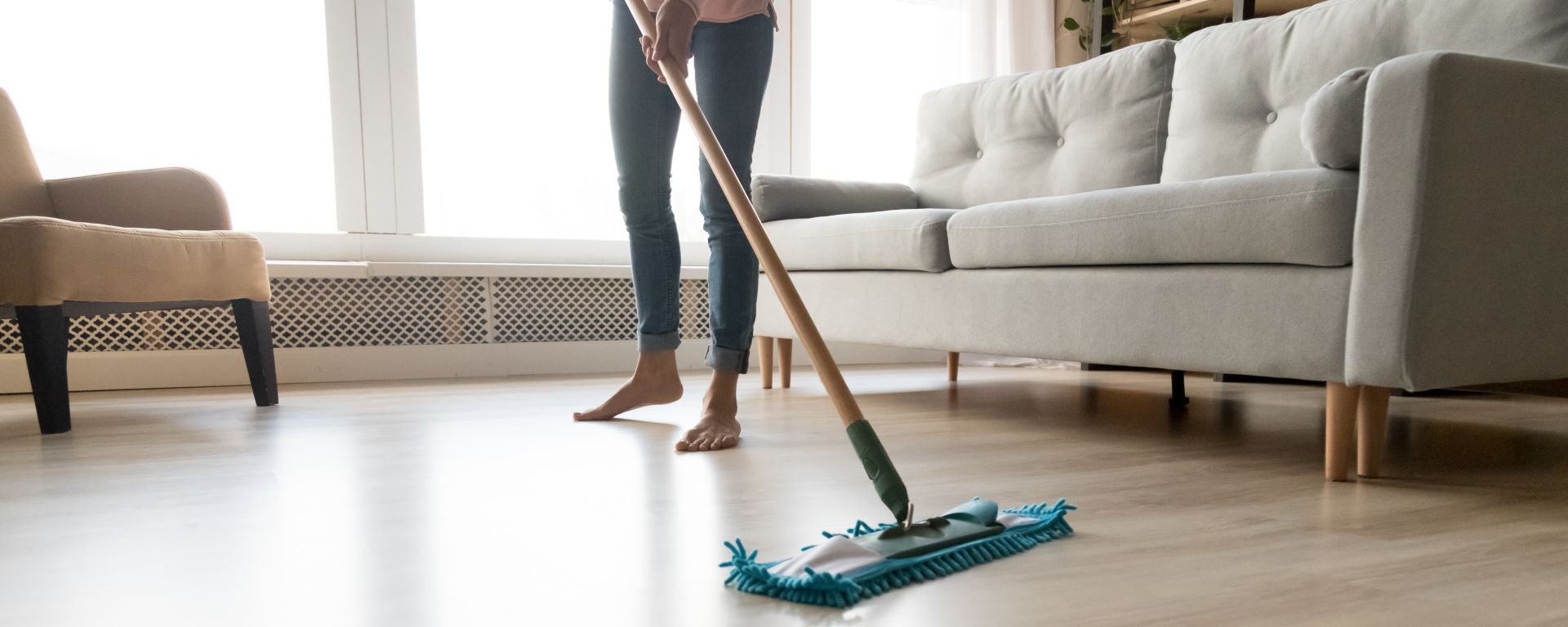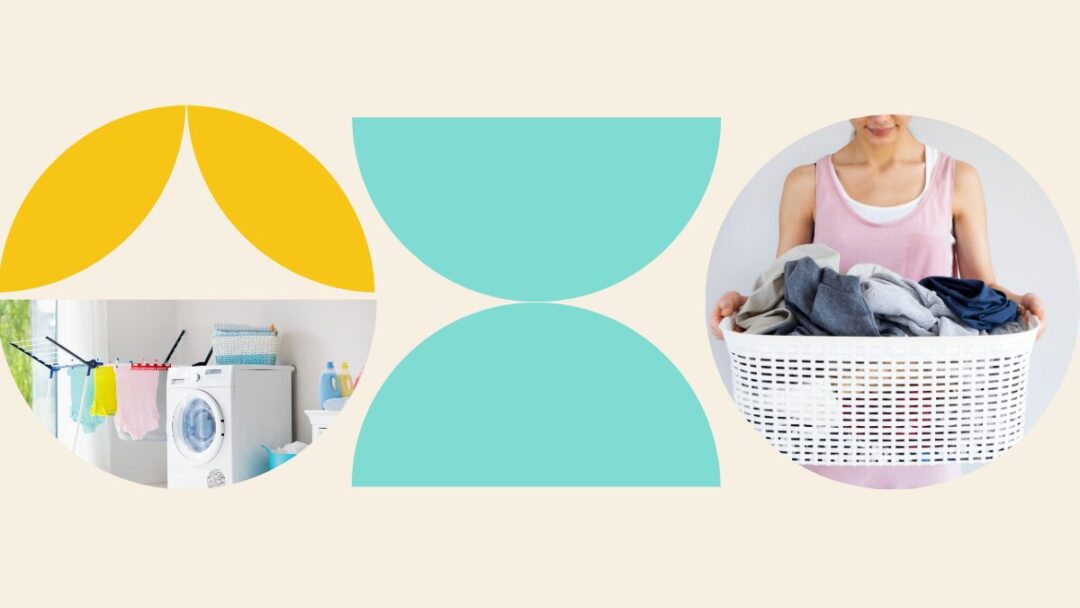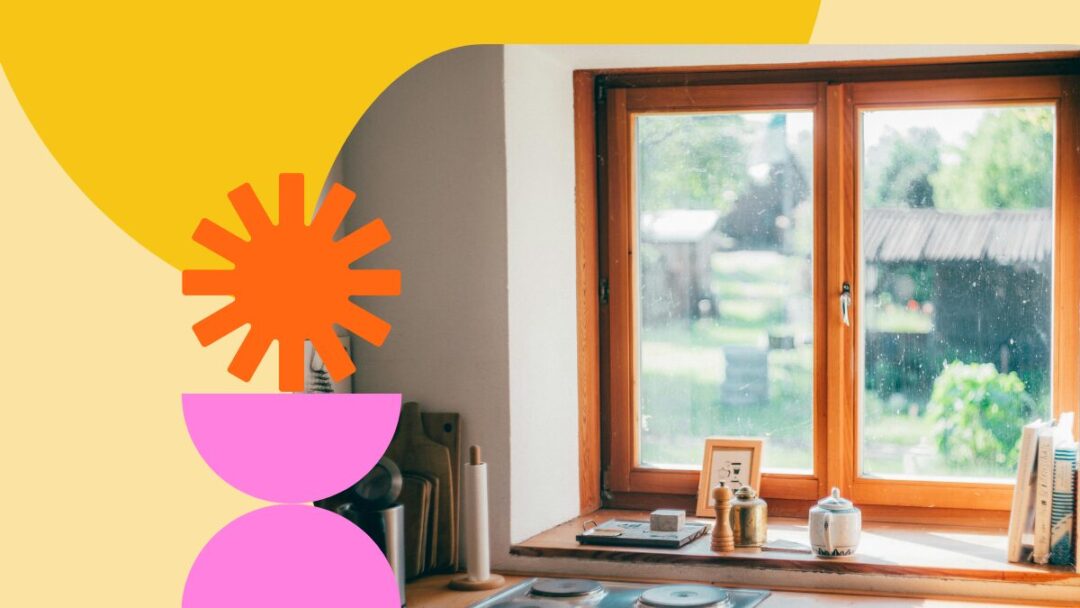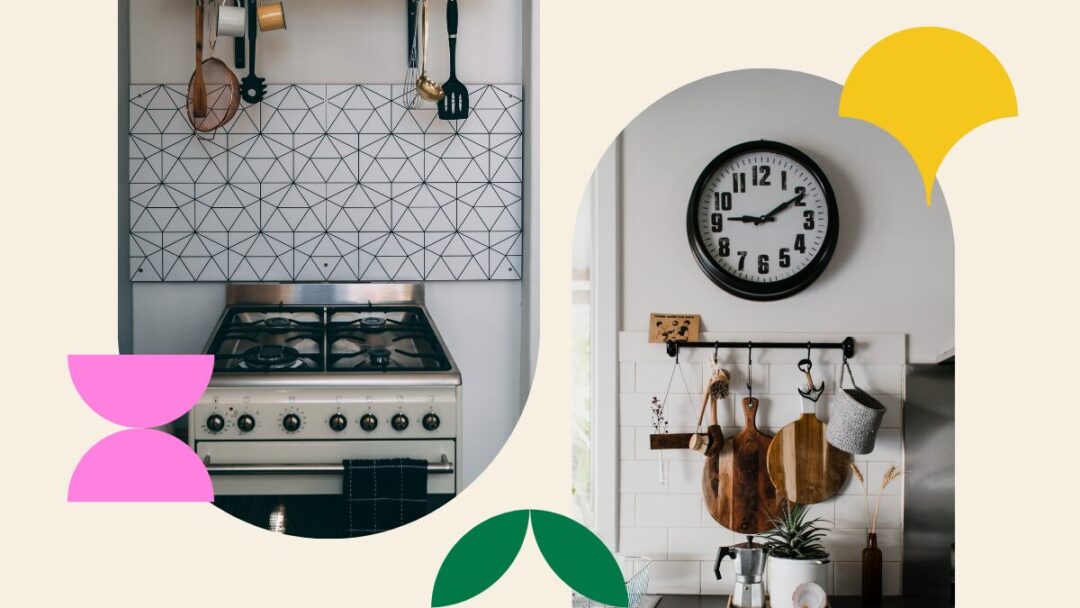Whether you have decade-old tile flooring, or new laminate floors, cleaning them will extend their life. Installing new flooring isn’t cheap, so you must protect your investment with proper maintenance. You should first check the manufacturer’s guidelines for information on cleaning the floors, maintenance, and refinishing your floors. This article will give you some universal cleaning tips for different types of floors commonly found in most homes. When springtime is closing in, it’s time to start spring cleaning, which includes your floors. Keep on reading to learn how to clean and mop different floors, protecting them from moisture, scratches, and spot potential damage.
How Often Should Floors Be Mopped
Floors should be mopped as often as you see suitable, usually every few weeks or once a month for low foot traffic areas such as the laundry room, office, and guest room. You may need to mop at least once a week for high-traffic areas like the kitchen, living room, bathroom, bedrooms and hallways.
You should be sweeping or vacuuming the floors more than you mop them. Sweep or vacuum the floor before mopping too – it’s important to pick up loose dirt and dust to prevent it from spreading once you begin mopping the floors.
What Type Of Mop To Use
Here are the different types of mops you can choose from for your flooring:
- Dust mops: can be used for daily, light cleaning on floors and other surfaces, including the ceiling and walls. These mops are not recommended for heavy-duty cleaning or saturated mopping.
- Flat mops: are good for getting into corners and usually come with reusable ends. They are not great for scrubbing hard to get rid of dirt and grime.
- Sponge mops: are good for absorbing spills and scrubbing. They may however dirty your tiles grout and leave behind streaks.
- Steam mops: are good for thorough cleaning and disinfecting of high-traffic areas. Steam mops can be pricey and are not recommended for real wood or laminate floors.
- String mops: are budget-friendly and good for reaching corners. The only downfall is that they require a bucket to wring out the water before mopping.
What Else Is Needed For Mopping Floors
Other things you will need for mopping the floors:
- A vacuum cleaner or broom to pick up loose bits of dirt before you begin mopping.
- Two buckets, one for your cleaning solution and one to rinse your mop after mopping with the cleaning solution.
- A cleaning solution, either homemade or store-bought, that’s been approved by your manufacturer.
- Rags or soft cloths to help you wipe the floors dry.
How To Mop Your Floors
When you’re mopping floors, there are some things to keep in mind when it comes to the type of floor you have. But firstly, here are some general steps that apply to all floor types:
- Grab your mop, buckets and cleaning solution. Choose what type of mop you want to use and choose the best cleaning solution for your type of floor.
- Vacuum or sweep your floors. Remember, get all of the food, dust, dirt and grime off your floors to avoid causing a larger mess or possible damage to your flooring.
- Plan your entry and exit, and begin. Start mopping away from the exit of the room and work your way backwards. This will help you avoid stepping over wet spots and making your floors dirty again.
- Follow the grain. While mopping your laminate floors, mop in the direction of the grain. Use the number 8 motion if you’re using a rag or string mop.
- Wring out the excess water. For most flooring types, too much water is a bad thing as it can damage your floors, especially hardwood and laminate flooring.
- Get down and use the sponge. For stubborn, hard-to-remove spots or stains, go over the area again. Just be ready to get on your hands and knees for scrubbing purposes.
- Let the area dry. Air dry your floors or use soft lint-free cloths to wipe your dry.
- Clean your mop and bucket. Keep your supplies clean by rinsing out your bucket and mop. Prevent bacteria growth by cleaning these items with a bleach and water mixture.
Now that you’ve got the basics of mopping your floors down. Let’s look at how much water to use, the type of mop to use, and tips for cleaning hardwood, tile, laminate, vinyl, and concrete flooring.
How To Clean Hardwood Floors
Hardwood floors are durable and timeless. Wooden floors are usually engineered or solid, with common types of hardwood including oak, pine, cherry, walnut, hickory and maple.
These mopping and vacuuming tips are to help ensure that you can keep your floors clean and protected for years to come, regardless of the type of wood. Check your owner’s manual to find out the best cleaning solution to use on your floors.
Some good points to remember:
- Sweep or dust-mop frequently: With a high-quality broom, commit to sweeping hardwood floors once a day. This is to help eliminate grime.
- Vacuum once a week: Use a vacuum without the beater bar to remove any debris that falls between slats.
- Wipe spills right away: This is especially important for stains and sticky spots. The longer you leave spills on hardwood floors, the better the chance of permanent stains and damage.
The best cleaners for hardwood floors are cleaning solutions recommended by floor manufacturers or floor cleaning professionals. For hardwood floors that have a polyurethane finish, use a little bit of warm water and a pH-neutral soap. For stains, you can use some warm water and white vinegar. For urethane finishes, use a water-based cleaner, as vinegar can damage this type of finish. Lastly, for a wax finish, use a solvent-based cleaner and liquid wax. You should avoid using too much water.
Tips To Maintain Hardwood Floors
Use these tips in addition to regularly cleaning your hardwood floors. Maintaining your floors can keep them from fading, scratches, dents and other damage.
- Use rugs and mats: Add rugs and mats in high-traffic areas, and spots where water damage could occur. For example, for hardwood flooring by your front door, a welcome mat can protect the floor from becoming scuffed by rocks and other debris. Also, if you have hardwood floors in the kitchen by the sink, a mat will help to keep them dry.
- Control the humidity: Hardwood flooring can warp and swell during the warm summer months. Try to keep your home between 15 to 27°C and 30 to 50% humidity throughout the year.
- Protect floors from furniture: Cover your furniture feet with felt or any other soft material to prevent scratches from appearing on the floors.
- Recoat: For hardwood floors that are starting to look dull, recoating can restore them to life.
- Refinish: When recoating isn’t enough, this may be from severe scratches and dents. You may need to sand and refinish your hardwood floors. However, if you have engineered hardwood floors, they may not be able to be finished as often as solid wood floors.
Things To Avoid
- Don’t use cleaning products that leave a residue.
- Never use an all-purpose cleaner; rather use a specialised type of cleaning product that is made for hardwood floors.
- Don’t overdo the water, use a damp mop with warm water – it shouldn’t be sopping wet. If the mop holds onto too much water, wring it out thoroughly.
- Never use cleaners that contain ammonia.
- Never use oil soaps.
- Never use a steam mop on hardwood floors.
How To Clean Laminate Floors
Laminate floors are durable and affordable, and have grown very popular over the years. If you have laminate floors, here are cleaning and maintenance tips to help ensure the longevity of your laminate floors. Before you start, read the manufacturer’s manual, and check online if you no longer have the manual on hand.
- Start by sweeping your laminate floors: Regular sweeping can cut down the possible damage that abrasive dirt can cause to your laminate floors. Try to sweep your floors at least once a day.
- Vacuum without a beater brush: To pick up all debris that has fallen into the cracks, corners and any other hard-to-reach areas.
- Use a damp mop: Never use lots of water to mop laminate floors as it can expand, swell and crack. Be sure to always wring out your mop first.
Read your manufacturer’s guide to see what products they recommend for cleaning laminate floors. If you’re unable to find it, choose a specific laminate floor product. Make sure not to choose an oil-based cleaner, these types of cleaners can leave a film and streaks. Don’t use a cleaner that is made with wax or polish either. If you prefer a homemade cleaner, create a mixture of vinegar and water.
Maintenance For Laminate Floors
- Add rugs and mats in high-traffic areas, such as doorways, the kitchen and hallways areas that would need a rug for additional protection.
- Laminate floors are not suitable for the bathroom. If your kitchen has laminate floors, be careful with water. Protect your floors by keeping them dry.
- Prevent scratches by using glides and floor protectors, and when moving furniture, lift instead of dragging.
Mistakes To Avoid
- Never use a cleaner that needs excessive amounts of water.
- Never use a steam mop or steam to clean the floors.
- Never directly apply any cleaner to laminate floors.
- Never use oil-based cleaners.
- Don’t sand or refinish laminate floors.
- Never use abrasive cleaners or cleaners made with polish or wax.
- Never use steel wool or scouring powder.
- Never use wax or a product that leaves a protective coating. This could turn your laminate floors grey or yellow.
How To Clean Vinyl Floors
Vinyl is another popular choice for those looking for an economical alternative to hardwood and stone. Vinyl floors come in an array of styles and designs. Modern vinyl flooring is designed to be waterproof, which makes it an ideal option for your bathroom, kitchen, and any other room susceptible to liquid spills. Vinyl flooring is also durable and available in large sheets.
Keeping vinyl flooring clean is relatively simple. Following cleaning and maintenance tips will ensure your floors remain in the best condition for the longest time:
- Sweep and vacuum every day – vinyl is durable, but sand, dirt, and grit can still possibly cause damage to the surface.
- Use warm water to clean your vinyl floors.
- Use a soft mop, like one made from microfiber, rather than an abrasive scrub. Rinse with clean water.
Before cleaning vinyl flooring, check the manufacturer’s recommendations for the right cleaning products. Most vinyl flooring can be cleaned with no-rinse cleaners. You can also use apple cider vinegar and water to clean the floors.
Maintenance For Vinyl Flooring
Vinyl flooring is incredibly low maintenance and holds up against water and foot traffic. It can last for longer if you follow these maintenance tips:
- Clean up spots and spills as they happen.
- Place mats and rugs near the door, but avoid rubber-backed mats that might leave a stain or dark mark.
- Use floor protectors for your furniture to avoid scratching your vinyl floors.
- Wipe up spills instantly to avoid permanent stains and moisture.
Things To Avoid
- Never use abrasive cleaning products or damaging chemicals.
- Never use rough scrub pads or scrub brushes to clean.
- Never use mop and shine products that will leave a residue or film.
- Never use wax polish.
- Never use a vacuum with a beater bar.
- Never use a large amount of water, it could destroy the glue bond and your floor’s edges could lift. You may even begin to see bubbles.
How To Clean Tile Floors
Tile floors are typically found in bathrooms and kitchens. It is an excellent choice for moist or wet areas. People love tile floors as they come in many styles, designs and materials, such as ceramic and porcelain tiles that are usually used for shower tiles and shower walls. Other materials used for tiles are marble, granite, limestone, to name a few.
Taking proper care of your tiles is key to ensuring that they can be enjoyed for many years. As there are so many different types of tile, always check the cleaning instructions in the manufacturer’s guidelines.
Tile Mopping And Cleaning
- Before you begin vacuuming, be sure that your vacuum doesn’t have a beater bar, as this can scratch your tile. Sweeping and vacuuming will allow you to quickly remove any loose dirt from your tile floors. You can also use a dust mop.
- Mop your tile floors once dirt has been vacuumed from your floors. Use a soft, damp mop with a manufacturer-approved tile and grout cleaner. You may also be able to use a neutral pH cleaner on tiles that are made from natural stone.
- Deep clean the tile as debris and grime build-up. Utilise a soft brush and an all-purpose cleaner or mild detergent. Gently scrub the tile and grout to remove the dirt. Once cleaning is done, rinse the tiles and dry thoroughly.
- To clean the grout, apply a recommended cleaner and use a stiff brush to scrub the grout. Once the cleaner is applied, vacuum up the residue with a wet/dry vacuum.
Many products can be bought for tile flooring, such as all-purpose cleaners and pH-neutral soaps. Be sure they adhere to your manufacturer’s guidelines. Some DIY cleaning solutions for your tiles and grout are:
- All-purpose cleaner or mild detergent and warm water.
- White vinegar and warm water.
- Baking soda and warm water.
- Baking soda, hydrogen peroxide, and washing up liquid.
Maintenance Tips For Tile Floors
- Clean up spills straight away; spills left for too long can permanently stain your tile, especially the grout.
- Although tiles are durable and sturdy, avoid dragging heavy furniture across the surface. Always use furniture protectors on tiles.
- Use non-slip mats or rugs to protect the floors.
- Talk to a professional about sealing your tile flooring. If moisture or water permeates the tile, it will damage it.
Mistakes To Avoid
- Never mix bleach and ammonia.
- Never use acid-based cleaners.
- Never use steel wool or scouring powders.
- Don’t use abrasive cleaners like dry cleansers or soft cleansers on natural stone tiles.
- Never use vinegar, lemon juice, or other acidic cleaners on marble, limestone, travertine, and the like surfaces.
How To Clean Concrete Floors
The most durable type of floor is probably concrete. Concrete is no longer a solely outdoor material. A common option for basements and garages nowadays is concrete floors. They are designed to look pretty, modern, and are easy to maintain.
Here are the tips to keep in mind when cleaning concrete floors:
- Begin by sweeping or vacuuming. Cleaning floors regularly to remove debris and dust is the most ideal way to help protect your concrete floors.
- Next, you can mop the floors. Concrete floors can withstand water, making them easy to mop. Use mild detergent and warm water to mop the floors.
- Then rinse thoroughly and dry your concrete floors after mopping.
Maintenance For Concrete Floors
Concrete is easy flooring to maintain. Follow these tips to prevent cracking and uphold its polish:
- Dust often to prevent possible scratches and damage.
- Try see to spills and stains as quickly as possible to prevent permanent damage.
- Get your floors sealed to stop water from getting through and to prevent stains. If you have polished concrete, it does not have to be resealed.
- Read your manufacturer’s guide to find out how often your concrete should be sealed. Generally speaking, it should be resealed every couple of years.
- Consider applying wax on top of the sealant, but polished concrete doesn’t require any wax.
- Fix any cracks. If not, dirt will get trapped in them.
- Use floor mats or rugs to prevent floors from getting dirty.
Mistakes To Avoid
- Never use harsh cleaners such as ammonia, bleach or vinegar. These can damage the concrete’s seal.
- Never use steel wool or a metal wire brush to clean concrete floors.
- Avoid using muriatic acid to clean concrete floors, especially if you’re planning on staining them in the future.
How To Clean Marble Floors
Marble is one of the most luxurious types of flooring. This natural stone is simply timeless and elegant. Keeping marble floors clean and maintained is vital to ensure the longest lifespan possible with minimal repairs.
The following cleaning tips will help keep your marble floors shiny and sparking:
- Marble floors should be cleaned often with a dust mop. The cleaning frequency depends on how many people and pets are in your home. Clean at least once a week if you live alone, twice a week if more than two people are in your house, and so forth.
- Only use soft microfiber cloths on marble flooring, never scrub brushes.
- When cleaning with a commercial product, make sure it’s a pH-neutral product. This is to reduce streaking and residue build-up.
- After cleaning, always dry your marble floors. This is to ensure that iron oxide in the water doesn’t leave behind rust stains.
Maintenance For Marble Floors
- If you spill, dab it up immediately. Spills left on marble floors can lead to stains and etches.
- Use the right cleaners to prevent etching, be sure to take a look at the manufacturer’s guide for a list of the best cleaning products.
- Be sure to know the difference between stains and etches so that you can use the right cleaners. Stains typically have spots that are darker in colour than the surrounding marble. Etches are spots that are lighter than the stone.
- You may want to consider sealing your marble to make it resistant to spills and stains.
Mistakes To Avoid
- Never use cleaning products with acids, such as vinegar or lemon juice.
- Never use harsh cleaning chemicals on marble floors.
- Never attempt to scrub the floors with scouring powders.
The Best Thing To Clean Floors With
It’s best to use a cleaning solution that’s recommended by your floor’s manufacturer. If you want to take the DIY route, keep these guidelines in mind:
- Hardwood: Choose a pH-neutral cleaner and warm water. Go easy with white vinegar, as this may damage the finish. Avoid using too much water.
- Laminate: You can use vinegar and water, but do not use too much water on laminate flooring.
- Tile: You can try using vinegar and warm water, baking soda and warm water, baking soda, or hydrogen peroxide and dish soap.
- Concrete and marble: Use a pH-neutral cleaner with warm water. Avoid citrus, vinegar, bleach, ammonia and the like.
Vinegar can be a good cleaning agent for tile and laminate flooring. But, be careful when using vinegar on wood floors. Due to the acidity of the vinegar, it must be diluted with water to prevent damaging hardwood floors. Avoid using it on concrete and natural stone flooring.
Whether you need to clean your laminate, hardwood, concrete, tile floors, and so on, make sure to make the necessary repairs or sealing. Regularly inspect the condition of your floors, clean them, and have them repaired immediately. After all, taking care of your floors is key to keeping them comfortable and clean, and protecting your investment. If your lifestyle doesn’t allow you the time to clean your floors or you would like your floors cleaned by a pro, head on over to our website and book a clean with a SweepStar today.








